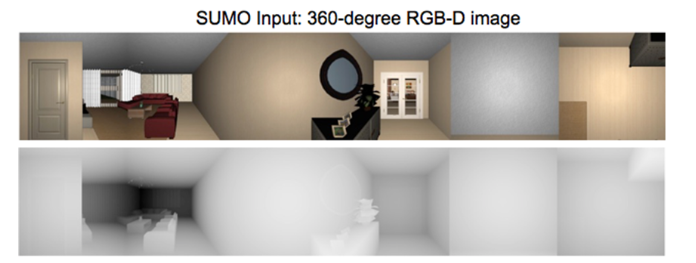Facebook Reality Labs have launched the Scene Understanding and Modeling SUMO Challenge. The challenge is designed by a group of computer vision researchers at Facebook with collaborators from Stanford, Princeton and Virginia Tech. The goal of the challenge is to aid the development of comprehensive 3D scene understanding and modeling algorithms.
For the SUMO challenge, participants are required to generate an instance-based 3D representation of an indoor scene given only a 360-degree RGB-D image taken from a single viewpoint. The generated scene is modeled by a collection of elements, each of which represents one object, such as a wall, the floor, or a chair.

Source: Facebook Blog
What are the three types of tasks?
The SUMO Challenge is organized into three performance tracks based on the output representation of the scene. Participants can join in any of the three increasingly detailed and difficult performance tracks.
Bounding Boxes Track: The scene is represented by a collection of oriented bounding boxes. This is similar to the SUN RGB-D Object Detection Challenge. The bounding box is the coordinates of the rectangular border that fully encloses a digital image when it is placed over a page, a canvas, or a screen.
Voxels Track: The scene is represented by a collection of oriented voxel grids. A voxel represents a value on a regular grid in three-dimensional space.
Meshes Track: The scene is represented by a collection of textured surface meshes. A mesh is a collection of vertices, edges and faces that defines the shape of a polyhedral object in 3D computer graphics and solid modeling.
How are the tasks evaluated?
The SUMO evaluation metrics focus on four aspects of the representation: geometry, appearance, semantics, and perception (GASP). Participants will be evaluated on their ability to consistently infer the correct geometry, pose, appearance and semantics of the elements in each scene.
The challenge runs from August 29th until November 16th, 2018. The top winners in each track will receive prizes, including cash rewards and NVIDIA Titan X GPUs.
- 1st prize – winner of mesh track: $2,500 in cash + Titan X GPU
- 2nd prize – winner of voxel track: $2,000 in cash + Titan X GPU
- 3rd prize – winner of bounding box track: $1,500 in cash + Titan X GPU
Winners will be announced at the SUMO Challenge Workshop on December 2nd at ACCV 2018, where they will present their results.
How to Participate
- Familiarize yourself with the input and output formats.
- Download the SUMO software and the data set. See the data set page for details.
- Develop your algorithm.
- Submit your results using EvalAI.
For more information, visit the SUMO Challenge website.
Read Next
Facebook launched new multiplayer AR games in Messenger.
Facebook to launch AR ads on its news feed to let you try on products virtually.










![How to create sales analysis app in Qlik Sense using DAR method [Tutorial] Financial and Technical Data Analysis Graph Showing Search Findings](https://hub.packtpub.com/wp-content/uploads/2018/08/iStock-877278574-218x150.jpg)


